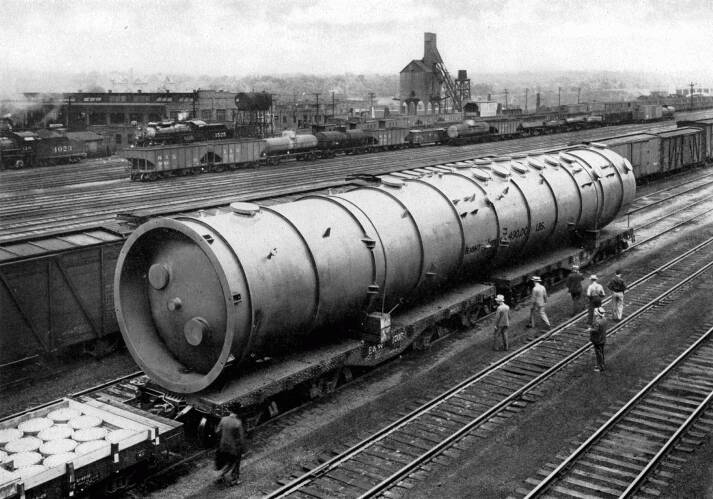 Railroads Carry "Anything, Anytime"
Railroads Carry "Anything, Anytime"
Railroads are unique among transportation agencies in that
they are able to handle shipments of every kind.
In their role as mass movers for the world's greatest industrial
nation, they are frequently called upon to perform transportation
tasks of truly herculean proportions-tasks indeed which could
not be performed by any other mode of transportation.
Great generating units and transformers for power plants; huge
tubings for subterranean structures; immense steam engines for
manufacturing plants; great turbines for steamships; huge paper-making
machines for paper mills; immense printing presses for metropolitan
newspapers; steel girders for bridges and other structures; long
flag poles and spars; forgings for industrial plants and dams;
boilers; tanks; heavy machinery for automobile plants, for coal
mines, and for refineries, foundries, machine shops and rolling
mills—these are some of the many Brobdingnagian shipments
that move over the American railroads.
In the picture is shown a bubble tower, or fractionating column,
used in the refining of petroleum. It is 91 feet long, about 18
feet in diameter, and weighs approximately 490,000 pounds. This
huge shipment, loaded on two flat cars, was hauled from Missouri
to Texas in 1938. It is said to hive been the largest single unit
shipment ever handled by the railroads of the United States.
The freight cars upon which the shipment was loaded were of
extra heavy steel construction capable of bearing great loads.
Most freight cars are equipped with eight wheels—a double
truck at either end—but it will be noted that each of these
cars is equipped with sixteen wheels, consisting of two double
trucks at either end.
The enormous weight of the bubble tower was distributed on
two pivoted bolsters, one on each car, and the tower was held
firmly in place by steel cables. The pivoted bolster was necessary
to allow sufficient flexibility for the cars to negotiate the
curves encountered along the route. The pivotal parts were greased
so as to reduce friction to the absolute minimum.
Before a shipment of this kind is sent on its journey, the
railroad or railroads which handle it must make certain that it
will clear all overhead structures, wires or other objects along
the route. If the most direct route does not have sufficient clearances
to accommodate the shipment, it is given another routing.
The tallest big-unit shipment on record was an electrical transformer
standing 18 feet 10 inches above the platform of the railroad
car, shipped from a manufacturing plant in Pennsylvania to a power
plant near Niagara Falls, New York.
The longest big-unit shipment on record was a steel girder
156½ feet in length—about half the length of a football
gridiron—shipped from a manufacturing plant in Pennsylvania
to a point near New York City, for use in the construction of
a highway bridge. Six flat cars were required to carry it. Its
weight of 308,000 pounds was distributed on two pivoted bolsters
resting on the second and fifth cars of the 6-car unit. The other
four cars carried no part of the load but acted as "spacers."
Two big railroad cranes were required to unload the girder and
fit it into place.
Among the many unusual shipments which the railroads have been
called upon to handle was the almost priceless 200-inch telescope
lens shipped from Corning, New York, to Pasadena, California,
for the world's largest telescope at Mt. Wilson Observatory. The
slightest fracture, cracking or chipping of the lens would have
ruined it and set the completion of the telescope back for years.
Therefore, the lens was packed for shipment with the utmost care
and was attended and guarded constantly on its 2,960-mile trip
across the continent. The lens reached its destination and was
delivered to the observatory in perfect condition.
This picture is taken in a large railroad yard. Note (1) the
many railroad tracks; (2) box cars, in foreground behind bubble
tower; (3) round-house and (4) steam locomotives, in left background;
(5) oil tank, to right of Engine 1525; (6) hopper cars, this side
of Engine 1525; (7) tank cars, next to hopper cars; (8) dump cars,
in background above right end of bubble tower; (9) cabooses, beyond
tank cars; (10) cooling station, tall structure in center background;
(11) water tank, to right of cooling station.
I've Been Working
on the Railroad | Contents Page
|







